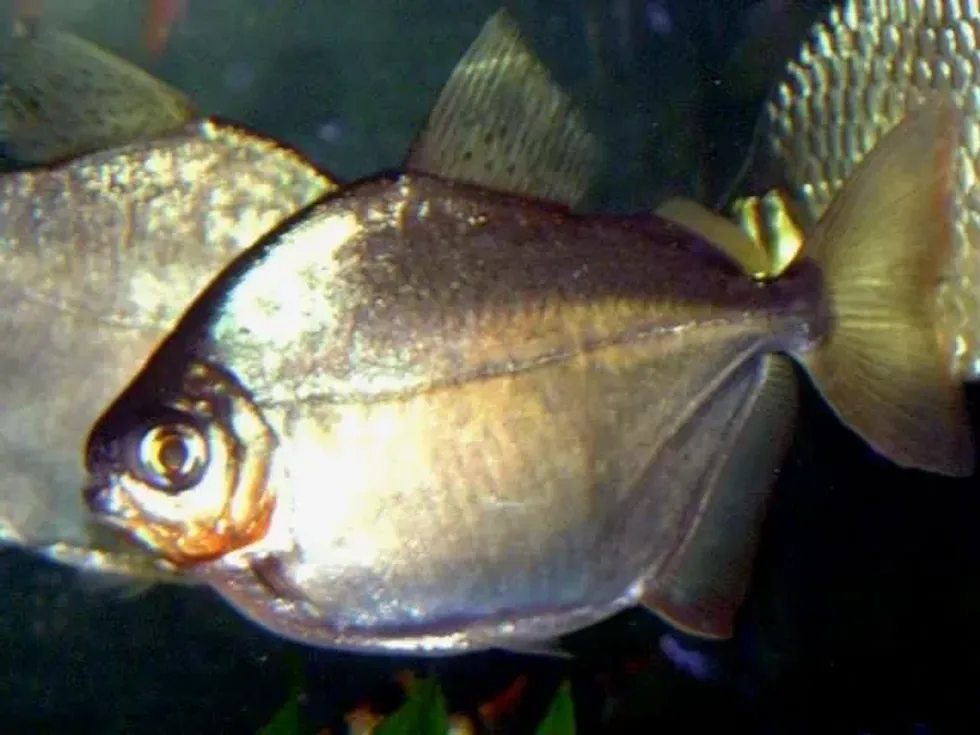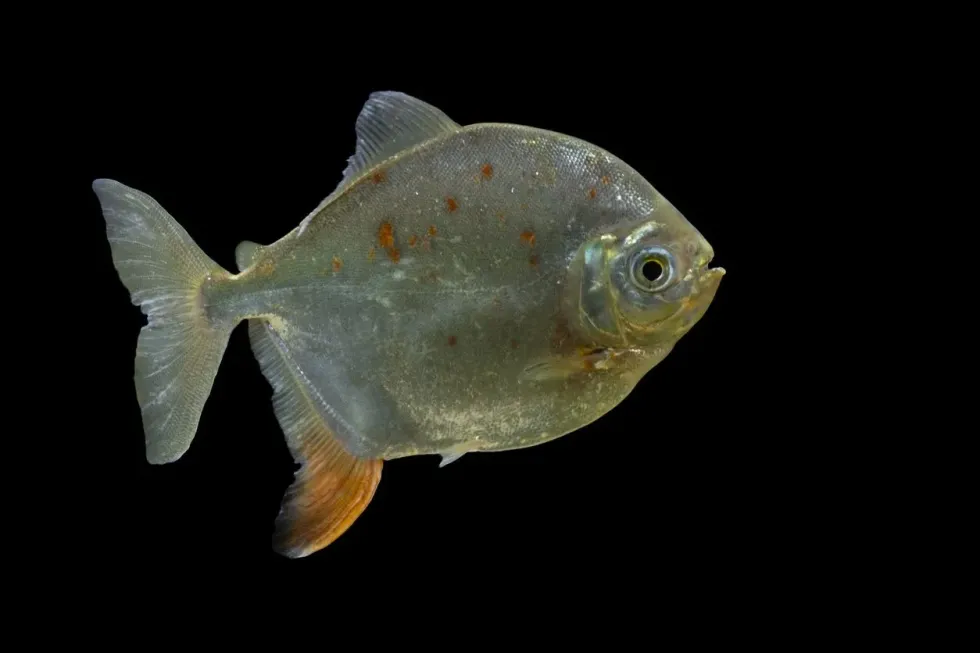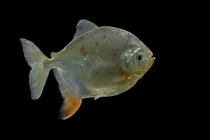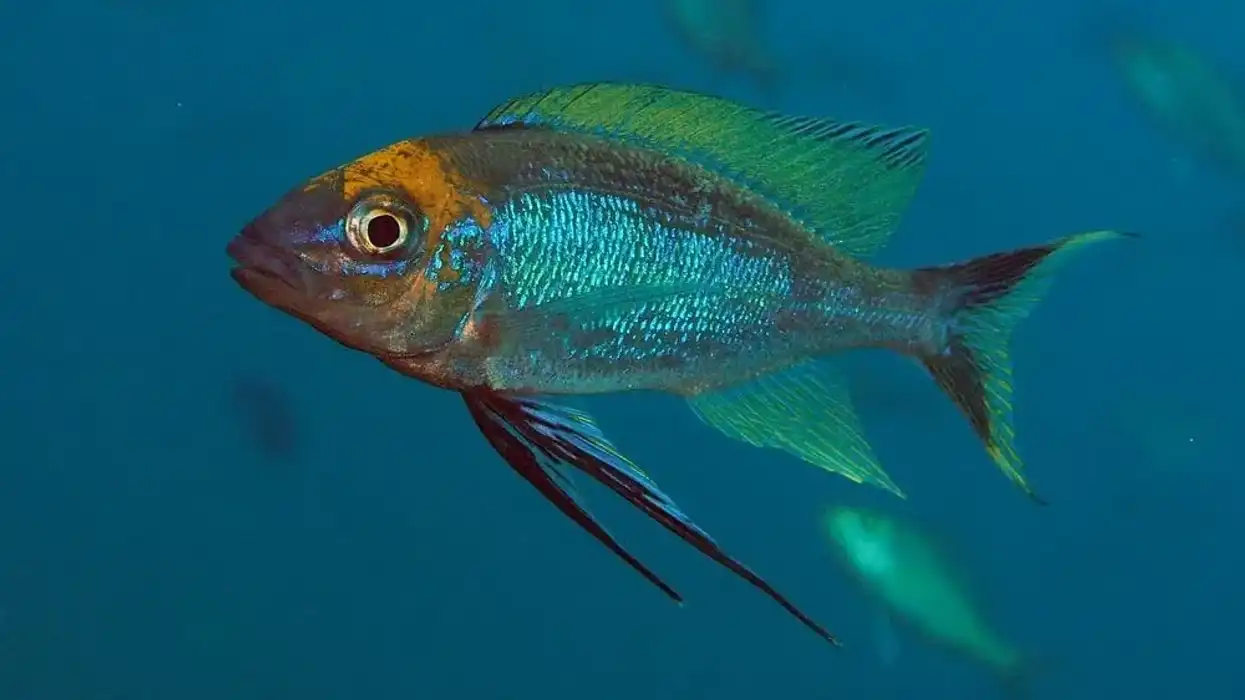Fun Silver Dollar Fish Facts For Kids

Silver dollar fish (Metynnis argenteus) are one of the most peaceful fish species that are closely related to the piranha or pacu family.
They are freshwater fishes that usually prefer herbivorous diets but also feed on blood worms, glass worms, or normal small worms as a treat. Although silver dollar fishes are not very aggressive, they have flat silver bodies with sharp teeth that are known to cause serious bites and injuries.
These fishes are also very popular among pet owners as they are greatly peaceful fishes that are completely safe to have living with other fishes.
They are amongst the popular choices for fishes that are kept in aquariums due to their attractive and catchy color, along with the fact that they do not hurt other fishes, their eggs, or even young ones. There are five types of silver dollar fish.
You may also look at paddlefish facts and rockfish facts for more information on the animal kingdom.
Silver Dollar Fish Interesting Facts
What type of animal is a silver dollar fish?
A silver dollar (Metynnis argenteus) is one of the species of fishes that are very closely related to the piranha family and can be dangerous as they have really sharp teeth. They are also the calmest members of the piranha family.
The scientific name of the species is Metynnis argentus, while the common name is silver dollar. Silver dollar is one of the most popular fish species that is a great community fish and is the best suited for private aquariums as well as community tank.
What class of animal does a silver dollar fish belong to?
Silver dollar fishes (Metynnis argenteus) belong to the class of Actinopterygii and family Characidae. They are closely related to the piranha or pacu fish family. It is a schooling fish species that can thrive in normal water conditions.
How many silver dollar fish are there in the world?
Silver dollar fishes are known to live in tropical waters that offer rich vegetation and plantation that serves as the food to these fishes. It is practically impossible to find out the number of silver dollar fishes in this world, but they are nowhere near extinction and have large populations especially in South America.
Silver dollars also reproduce really fast and are known to lay around 2000 eggs at once which helps in keeping their population almost intact.
Where does a silver dollar fish live?
Silver dollar (Metynnis argenteus) species is abundantly found in South America. Silver dollars are also one of the most common and preferred aquarium fishes around the world.
They are suitable as pet fishes and also found in the wild. It is a freshwater fish, found in the Amazon river basin, Tapajos river basin in Brazil, and is endemic to almost all the rivers of South America.
What is a silver dollar fish's habitat?
Silver dollar fishes are known to best adapt to warm tropical rivers that are rich in vegetation and plantation and serve them enough to feed on them throughout their life. These are freshwater fishes that are found in dark edges of rivers filled with debris, rocks, stones, gravel, and driftwood, which helps them to hide easily and effectively.
Their natural habitat includes moderate water flow with a warm temperature.
Who do silver dollar fish live with?
Silver dollar (Metynnis argenteus) is a type of schooling fish that are known to display their best behavior when kept in groups. Silver dollars are a community fish and are known to be best when kept in groups of around five individual members as it makes them feel safer and more protected.
How long does a silver dollar fish live?
The spotted silver dollar fish lifespan is said to be of around ten years on average but they can also live longer. When silver dollars are taken care of, these fishes are also amongst the longer-living fishes in the aquarium.
However, in the wild, silver dollar (Metynnis argenteus) life expectancy decreases a significant amount as they can be easy prey to other bigger fishes and reptiles.
How do they reproduce?
Silver dollar (Metynnis hypsauchen) males and females reach their sexual maturity at about one year of age or when they reach around 4 in (10 cm) of length. Male silver dollar fishes spawn and chase female dollar fishes for breeding.
Females lay eggs in water which are later fertilized by males.
The eggs will hatch in three days, and young silver dollar fishes can swim in around six to nine months after their birth. This species of fish will sometimes breed in a hospital, aquarium setting, or a breeding tank with floating plants.
What is their conservation status?
Silver dollar fishes are almost known to have around sixteen different species that are nowhere near being Extinct. It is also because these are rarely caught by humans for consumption or any other purpose and also lay around 2000 eggs at once that helps keep their population almost intact.
But there are various silver dollar fish diseases that are affecting their populations in the wild. Nevertheless, their official status has been listed as Least Concern.
Silver Dollar Fish Fun Facts
What do silver dollar fish look like?
As the name gives it away, a silver dollar fish resembles a silver dollar coin. These fishes have round, silver-colored flattened bodies that grow to an average of around 6 in (15 cm) long.
Although silver dollars are in shades of silver, they have slight patches or hints of green and blue that can be seen in red lighting.
Both male and female species of silver dollar fishes are largely identical but can be differentiated based on their fins, as males have large fins when compared to females. All the species have different appearances and coloring.

How cute are they?
Silver dollar fishes are really innocent and are very popular amongst aquarium fishes due to their striking color and features. Silver dollars are really cute and do not threaten other fishes or feed on them, unlike their closely related families of piranha and pacu.
If you are thinking of getting an aquarium with silver dollar fishes, then you must first acquire knowledge about the best suited tank mates and other things about silver dollar fish care.
How do they communicate?
One of the most common behaviors seen amongst red hook silver dollar fishes is they chase each other around. This is a sign of communication as well as breeding.
How big is a silver dollar fish?
Silver dollar fish size is perfect for aquariums. With medium-sized bodies and no aggressive behavior towards other fishes, silver dollars can be easily managed by their humans.
A silver dollar fish is known to have an average length of 6 in (15 cm) and can grow even more. Silver dollar fishes are usually two times the size of normal fishes, such as goldfish.
How fast can a silver dollar fish swim?
Silver dollar fishes are really quick and fast when compared to other fishes. Silver dollars are also very prone to eat all the food in the aquarium and have the capacity to eat loads.
How much does a silver dollar fish weigh?
Silver dollar fish keeping is easy and are amongst the smaller fish. Their adult size weighs a maximum of 2.2 lb (0.9 kg).
What are the male and female names of the species?
There are no special names given to the male and female species of silver dollar fishes. Silver dollars are commonly regarded as male silver dollar fish, and female silver dollar fish and are not very differentiated from one another.
What would you call a baby silver dollar fish?
A baby silver dollar fish is simply referred to as a juvenile or just a baby silverfish.
What do they eat?
Silver dollar fishes are one of the most innocent and calmest members of the piranha family, but when threatened, they can cause serious injuries through their sharp teeth. These fishes are primarily herbivores but are also known to eat meat and are omnivores.
Overall, silver dollar fish food includes a herbivores diet and are known to feed on surrounding habitation and plants. Silver dollars eat a variety of plants, including cress, lettuce, spring greens, peas, cucumber, chickweed, and much more that could be found in their surroundings.
Silver dollar fishes are ravenous eaters of a variety of plants and can eat almost all varieties of plants, and if you are planning to keep them at home, make sure to not place any real plants in their aquarium, and rather use plastic plants.
Although silver dollar fishes prefer a herbivore's diet, this species is especially fond of bloodworms, glass worms (mosquito larvae), and brine shrimp which silver dollars fondly eat as treats.
Are they eaten by humans?
No, silver dollar fishes are not popularly caught or consumed by humans. Silver dollars are famous as aquarium fishes and are absolute favorites that are loved by fish pet owners.
To meet this demand, silver dollar fish breeding is also popular and they are kept in a large tank in breeding pairs. Human owners select silver dollar fish tank mates based on the information available regarding silver dollar fish compatibility.
Would they make a good pet?
Yes, silver dollar fishes are very well known amongst aquarium keepers and are a great match to be kept in a fish tank or aquarium. Silver dollars are really easy to maintain and need very little understanding of silver dollar fish care except for that their habitat and food.
This species are best suited to be kept in an aquarium and do well with silver dollar fish tankmates. It's advised to give these fishes fake plants as tank accessories, or they might eat real ones.
Did you know...
Silver dollar fishes are very closely related to the families of piranha and pacu that are some of the most aggressive fishes of all time.
Although silver dollars are related to the piranha and pacu family that are especially known for their aggressive behavior, silver dollar fishes are surprisingly peaceful by nature and do not feed on other fishes or their eggs.
The unique features of a silver dollar fish is its silver-colored flattened body that resembles a dollar coin, hence the name.
There are around sixteen different species of silver dollar fishes across the world. Some of the most common species of silver dollar fish include red hook silver dollar fish, spotted silver dollar fish, black-barred silver dollar fish, tiger silver dollar fish, etc.
Silver dollar fishes are suitable to live with with tank mates like angelfish, firemouth, plecos and doradids, pacus and anostomus.
This fishes can cost between 7 to 20 USD depending on where you buy them from.
How long are silver dollar fish pregnant?
Uniquely enough, silver dollar fishes are amongst the egg-laying fishes that are known to lay even around 2000 eggs at once, near or in floating plants. After the females lay eggs, these transparent, slightly yellow-colored eggs are fertilized by males, and the eggs fall and float in the water. This means that they don't get 'pregnant' persay.
How do silver dollar fish get their name?
Silver dollar fishes are known to get their name from their silver-colored bodies that are extremely flat and resemble a silver dollar coin. This is the reason fishes of this species are named or called the silver dollar fishes.
Here at Kidadl, we have carefully created lots of interesting family-friendly animal facts for everyone to discover! Learn more about some other fish including longhorn cowfish, or pumpkinseed sunfish.
You can even occupy yourself at home by drawing one of our fish coloring pages.
We Want Your Photos!
More for You
See All
Bachelor of Science specializing in Computer Science

Christian MbaBachelor of Science specializing in Computer Science
Christian Mba is an experienced blogger and content writer with over a decade of experience. He holds a Bachelor of Science degree in Computer Science from Nigeria and has a keen interest in Python programming. Along with his writing and blogging expertise, he is also an SEO specialist with more than six years of experience. Chris, as he is commonly known, has a passion for music and enjoys playing the piano.
Bachelor of Arts specializing in English Literature

Deeti GuptaBachelor of Arts specializing in English Literature
A detail-oriented fact-checker with a research-oriented approach. Devika has a passion for creative writing, she has been published on multiple digital publishing platforms and editorials before joining the Kidadl team. Currently pursuing a Bachelor of Arts in English Literature from St.Xavier's College, Deeti has won several accolades and writing competitions throughout her academic career.
Disclaimer
1) Kidadl is independent and to make our service free to you the reader we are supported by advertising. We hope you love our recommendations for products and services! What we suggest is selected independently by the Kidadl team. If you purchase using the Buy Now button we may earn a small commission. This does not influence our choices. Prices are correct and items are available at the time the article was published but we cannot guarantee that on the time of reading. Please note that Kidadl is a participant in the Amazon Services LLC Associates Program, an affiliate advertising program designed to provide a means for sites to earn advertising fees by advertising and linking to Amazon. We also link to other websites, but are not responsible for their content.
2) At Kidadl, we strive to recommend the very best activities and events. We will always aim to give you accurate information at the date of publication - however, information does change, so it’s important you do your own research, double-check and make the decision that is right for your family. We recognise that not all activities and ideas are appropriate for all children and families or in all circumstances. Our recommended activities are based on age but these are a guide. We recommend that these ideas are used as inspiration, that ideas are undertaken with appropriate adult supervision, and that each adult uses their own discretion and knowledge of their children to consider the safety and suitability. Kidadl cannot accept liability for the execution of these ideas, and parental supervision is advised at all times, as safety is paramount. Anyone using the information provided by Kidadl does so at their own risk and we can not accept liability if things go wrong.
3) Because we are an educational resource, we have quotes and facts about a range of historical and modern figures. We do not endorse the actions of or rhetoric of all the people included in these collections, but we think they are important for growing minds to learn about under the guidance of parents or guardians.







